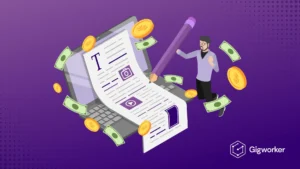Income volatility is a distinct change in the annual income of a worker from a given year to the next. These large swings in income are a more frequent occurrence than many people think, especially for gig economy workers, freelancers, and on-demand workers.
A report by Pew Charitable Trusts reveals that more than a third of Americans face up to 25% of fluctuations year on year. In this article, we examine the concept of income volatility, why it matters, and how workers can tackle it effectively.
What Is Income Volatility?
Income volatility refers to an inconsistency in income earned by a person or group of people. It describes the extent to which one’s earnings over a period vary from the average or the number of times a household’s monthly income dips and increases within a certain period, affecting their financial stability.
The rises and dips in paychecks in a given month are not always negative or resulting in loss. Sometimes, the impact of volatility can be positive on the income, and result in an income boost.
But often, volatile incomes leave workers and their household financial stability vulnerable, hence the need to properly understand how to mitigate the effects of the bumpy income ride.
What Is the Income Volatility Formula?
There is no universally accepted formula for calculating income volatility. It can be estimated in different ways based on the data that is available and the context in which it’s presented.
However, one popular method of calculating earnings volatility is standard deviation:
Standard Deviation (σ) = √[Σ(xi – μ)² / N]
σ = Standard deviation
Σ = The sum of all the values in the data points
Xi = Individual incomes at different periods
μ = The average income over a certain period
N = The total number of income entries
Note: This formula is different from the one for calculating the volatility of an asset or investment (vol= σ√T). The volatility formula doesn’t consider factors like expenses, employment changes, etc., in its calculation.
Here’s how the standard deviation formula works for calculating income volatility:
- Begin by calculating the average (mean) income over a certain period.
- Next, subtract the mean income (μ) from each income entry (xi).
- To eliminate negative values, square the results of each subtraction you’ve done.
- Add all the squared subtraction results together.
- Now, divide the derived figure by the total number of income entries (N).
- Find the square root of the result.
The final answer is the standard deviation — the measure of the dispersion or volatility of the income. If the standard deviation is high, it’s indicative of greater income volatility, and if it’s low, the income is more stable.
Who Does Income Volatility Affect?
Income volatility affects all demographic groups. In Pew Trusts’ report, 1 in 4 homes (of every educational status, income level, and race) experience volatility in their incomes. However, the research showed that it is usually consistent among some particular populations.
Volatility is more frequent among younger, single-parent families of color than other sets of households. It’s also prevalent among low to moderate-income families. High levels of volatility affect hourly workers who run irregular shifts or work part-time jobs.
This is because, in today’s world, employers leverage modern scheduling software to implement on-demand scheduling more easily. This allows shift or part-time job workers minimal control over the hours they can work.
Earnings volatility is concerning to many on-demand and gig workers because the unpredictability of the spikes and dips makes it difficult to save, create a budget, or sufficiently plan ahead to manage unforeseen money problems.
It also makes the idea of financial security a myth for these demographics.
How to Handle Income Volatility
Gig work is said to be one of the major causes of income volatility.
Workers in the gig economy don’t have a guaranteed minimum hourly pay for the services they provide. This means their jobs will not pay as steadily, nor as well as a conventional job offer. The instability of the expected pay from clients could sometimes leave gig workers in a dry spell, unable to cover basic expenses.
Gig work also offers no employment benefits since businesses do not consider on-demand workers as full-time employees. No benefits means no insurance packages, retirement plans, or freedom to save money from their base pay.
All of these can be overwhelming for on-demand service providers and lead to depreciating quality of life. Thankfully, there are strategies and tactics that workers can employ to mitigate and better manage income dips and swings.
1. Diversify Your Clients or Start a Side Job
If you run a freelance business, one of the ways to increase and stabilize your cash inflow is to diversify your clientele or find more consistent clients who will offer a long-term, well-paying work relationship.
If you work a traditional job, you can supplement your income with a side gig. In today’s digital world, it’s easy to start a side business or create other earning opportunities for oneself. For example, if you’re not keen on doing freelance work, you can sell digital products or get paid to run errands for people.
2. Start a Savings Fund
The subject of savings is a bit difficult for low-income earners or on-demand staff because of the instability of their income. However, it’s not one that should be written off because it can help to tide workers over when they hit a dry spell.
Because volatile earnings are unstable, sometimes, on-demand workers may receive paychecks that are higher than their average income. Instead of spending all the money on unnecessary expenses, keep away the excess in a savings account.
Plan ahead by creating a budget that will allow you to manage your income well and set aside some funds for emergencies. The 50/30/20 rule is a good budget plan to follow.
3. Track What You Spend, Analyze What You Earn
Volatile income earners must keep track of what they spend to ensure that they don’t exceed the assigned budget for necessary purchases. Analyzing one’s income is also key to preparing adequately for volatile seasons.
Conducting frequent income analysis using spreadsheets, income tracking tools, etc., will help you identify trends and repeated patterns in your income inflow.
Using the deductions from these analyses, you’ll be able to create improved spending strategies that will cushion the effect of volatility on your earnings.
Income Volatility FAQs
What is the Relationship Between the Need for Payday Lending and Income Volatility?
A volatile income can force workers to seek alternative financial services like payday lenders who charge high-end rates. Payday lending helps volatile income earners with bad credit scores and no other access to funds to cover urgent bills like rent or medical costs.
What is a Payday Loan?
A payday loan is a short-term, high-risk borrowing plan where the lender gives the borrower a high-interest credit on the premise that they get a portion of their next paycheck in return.
They’re typically used to settle urgent bills and have to be paid back in 30 days.








